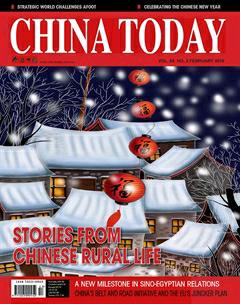Inheritor of Kashgar Earthenware
By ZHU MINGJUN
Inheritor of Kashgar Earthenware
By ZHU MINGJUN
T URSUN Zunun lives in one of the many adobe dwellings that form a tower of terraces in central Kashgar. Although the refurbished old town of Kashgar has relatively more ethnic features and customs, travelers to Kashgar invariably make a point of coming to see these terraced buildings that are a legacy of the Western Regions. Such buildings are generally built on loess cliffs.
The buildings appear as an island in Kashgar. They constitute a well preserved stronghold of folk customs. Known as an encyclopedia of Uygur folklore, the area’s exotic ambience renders it an eco-museum.
Ten years of maintenance and renovation have added still more charm to this historical city.
To preserve their historical outlook, the project that resettled residents of these terraced dwellings preserved the time-honored buildings that were their homes, rather than making large-scale renovations. Consequently, this group of adobe residences is last of its kind in Kashgar.

Many local adobe dwellings are built on loess cliffs.

One of Kashgar’s maze of alleys.
Occupying just 10 percent of the old city, the terraced dwellings embody most of the features of Kashgar’s old architectures. A walk through this part of town, with its variegated profile of both tall and squat adobe houses, arcades, maze of alleys, and curved Bridge Gallery, in whose workshops craftsmen produce their wares, gives one the feeling of being in a medieval time warp.
No one knows the origins of this platform of terraced dwellings. Their history is as complicated and confusing as the nearby maze of alleys. The Tuman River, which has nourished the old city for millennia, is the sole witness to its historical changes. Abundant local soil enabled local residents to make a living from firing bricks and making earthenware products. But urban expansion now precludes brickmaking. The few families that are adept at pottery are regarded as inheritors of localhistorical and cultural heritage.


Tursun Zunun, inheritor of Kashgar earthenwave.
KaShgar EarThENwarE
In the end Tursun Zunun decided to succeed to his father’s
livelihood and become an inheritor of the historical and cultural
heritage of pottery making.
Tursun Zunun is one such inheritor. After graduating from normal school he was initially dismissive of this skill handed down from his father, and keen to find a better-paying occupation. But he was also emotionally attached to what has now been his home of almost half a century.
In the end he decided to succeed to his father’s livelihood and become an inheritor of the historical and cultural heritage of pottery making. His kiln is in the small room where his parents once lived. He has modified that adjacent to it into an exhibition room. As the windows in the kiln room are small, the light is dim. This makes it the ideal place in which to fire the tri-colored glazed ceramics in the style of the Tang Dynasty (618-907), figured bowls, and pottery cups which are the most popular items.
From his courtyard one can see the winding Tuman River in the distance, and catch glimpses of bustling modern urban life on its opposite banks. Tursun Zunan is appreciative of both the convenience of modern life and traditional comforts that Kashgar offers.
The making and firing in Kashgar of simple, elegant earthenware bowls, dishes, and pots dates back 3,000 years. The entire process, from shaping, drying, glazing and firing, is carried out using earth from the loess cliff without drawings or templates.
The development of manufacturing has diminished the use of pottery products in people’s daily life. However, the growth of local tourism and popularity among visitors of this ethnically distinctive earthenware has invigorated the craft and created a new demand.
The local government has lent its support to the protecting and passing on of this ancient folk art as historical and cultural heritage. As the sixth-generation earthenware inheritor, Tursun has lived the life of a craftsman for more than 50 years, and won the support of national policy.
ZHU MINGJUN is a reporter for Xinjiang Daily.

